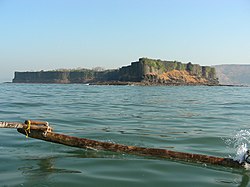Ratnagiri district
Thank you for being part of the Bharatpedia family! 0% transparency: ₹0 raised out of ₹100,000 (0 supporter) |
This article needs additional citations for verification. (January 2016) |
Ratnagiri district | |
|---|---|
 View of Suvarnadurg from the sea | |
 Map of Ratnagiri District | |
| Country | |
| State | Maharashtra |
| Division | Konkan |
| Headquarters | Ratnagiri |
| Tehsils | 1. Mandangad, 2. Dapoli, 3. Khed, 4. Chiplun, 5. Guhagar, 6. Sangameshwar, 7. Ratnagiri, 8. Lanja, 9. Rajapur |
| Government | |
| • Lok Sabha constituencies | 1. Ratnagiri-Sindhudurg (shared with Sindhudurg district), 2. Raigad (shared with Raigad district) (Based on Election Commission website) |
| • Vidhan Sabha constituencies | 5 |
| Area | |
| • Total | 8,208 km2 (3,169 sq mi) |
| Population (2011) | |
| • Total | 1,615,069 |
| • Density | 200/km2 (510/sq mi) |
| Demographics | |
| • Literacy | 82.18% |
| Time zone | UTC+05:30 (IST) |
| Major highways | NH-66, NH-204 |
| Website | ratnagiri |
Ratnagiri District (Marathi pronunciation: [ɾət̪n̪aːɡiɾiː]) is a district in the state of Maharashtra, India.[1] The administrative headquarter of the district is located in the town of Ratnagiri.[1] The district is 11.33% urban.[2] The district is bounded by the Arabian Sea to the west, Sindhudurg district to the south, Raigad district to the north and Satara, Sangli and Kolhapur districts to the east.[1] This district is part of Konkan division.[1]
History[edit]
From pre-Christian times until 1312, the area - like the entire region - was ruled by various Buddhist and Hindu rulers. The first state known by name was the Maurya Empire, the last non-Muslim dynasty were the Yadavas of Devagiri. After decades of military clashes with Muslim rulers in northern India, it was occupied by Muslim armies between 1312 and 1470. From 1500 on there was fierce fighting for rule on the coast between the Muslim rulers and the Portuguese. After that, various Muslim dynasties ruled until 1658 (Sultanate of Delhi, Bahmani, Deccan Sultanates and the Mughals).From 1658 most of the area became part of the Maratha Empire. After the defeat of the Marathas against the British in 1818, Ratnagiri area became an administrative region of the Bombay Presidency. With the independence of India in 1947 and the reorganization of the country, it became part of the new state of Bombay State in 1950. In 1948 the district grew through the incorporation of the Sawantwadi princely state. In 1960, Bombay State was divided and the area became part of the newly created state of Maharashtra. In 1981 the district was divided and the southern part of the district became Sindhudurg district.[3][4][5]
Geography[edit]
An outstanding feature of the geography of the district is its uneven or hill topography, with about 45% of the district being characterized as 'hilly'.[6] Very narrow riverine plains fringe the coastline.[6]
Demographics[edit]
According to the 2011 census Ratnagiri district has a population of 1,615,069,[7] roughly equal to the nation of Guinea-Bissau[8] or the US state of Idaho.[9] This gives it a ranking of 311th in India (out of a total of 640).[7] The district has a population density of 196 inhabitants per square kilometre (510/sq mi) .[7] Its population growth rate over the decade 2001-2011 was -4.96%.[7] Ratnagiri has a sex ratio of 1123 females for every 1000 males,[7] and a literacy rate of 82.43%. Scheduled Castes and Scheduled Tribes make up 4.15% and 1.26% of the population respectively.[7]
At the time of the 2011 Census of India, 88.18% of the population in the district spoke Marathi, 7.36% Urdu and 1.43% Hindi as their first language.[12]
| Year | Pop. | ±% p.a. |
|---|---|---|
| 1901 | 871,866 | — |
| 1911 | 893,944 | +0.25% |
| 1921 | 856,032 | −0.43% |
| 1931 | 964,558 | +1.20% |
| 1941 | 1,022,816 | +0.59% |
| 1951 | 1,076,080 | +0.51% |
| 1961 | 1,146,243 | +0.63% |
| 1971 | 1,278,742 | +1.10% |
| 1981 | 1,379,655 | +0.76% |
| 1991 | 1,544,057 | +1.13% |
| 2001 | 1,696,777 | +0.95% |
| 2011 | 1,615,069 | −0.49% |
| source:[13] | ||
See also[edit]
Notable people[edit]
Notable people from Ratnagiri include:
- Lokmanya Tilak
- Balasaheb Kher
- Dhondo Keshav Karve
- Vinoba Bhave
- Pandurang Vaman Kane
- Swatantryaveer Savarkar was moved to Ratnagiri with his freedom of movement restricted to the boundary of the district and also refraining from politics.[14]
- Govind Sakharam Sardesai
- R. P. Paranjpye
- Shakuntala Paranjpye
- Gopal Krishna Gokhale
- Sumitra Mahajan
- Madhu Dandavate
- Sadhana Sargam
- Sadha
References[edit]
- ↑ 1.0 1.1 1.2 1.3 District Census Handbook Ratnagiri Village and Town Directory (Part A). Directorate of Census Operations. 2011. Retrieved 12 March 2021.
- ↑ Census GIS India Archived 11 January 2010 at the Wayback Machine
- ↑ Greater Bombay District Gazetteer 1960, Ancient Period, pp. 127–150
- ↑ Greater Bombay District Gazetteer 1960, Medieval Period, pp. 150–157
- ↑ Greater Bombay District Gazetteer 1960, Muhammedan Period, pp. 157–163
- ↑ 6.0 6.1 Mishra, S.S.P. (2014). Groundwater Information Ratnagiri District Maharashtra. Nagpur: Central Ground Water Board. Retrieved 16 March 2021.
- ↑ 7.0 7.1 7.2 7.3 7.4 7.5 "District Census 2011". Census2011.co.in. 2011. Retrieved 30 September 2011.
- ↑ US Directorate of Intelligence. "Country Comparison:Population". Retrieved 1 October 2011.
Guinea-Bissau 1,596,677 July 2011 est.
- ↑ "2010 Resident Population Data". U. S. Census Bureau. Retrieved 30 September 2011.
Idaho 1,567,582
- ↑ "C-16 Population By Religion - Maharashtra". census.gov.in.
- ↑ 2011 Census of India, Population By Mother Tongue
- ↑ 2011 Census of India, Population By Mother Tongue
- ↑ Decadal Variation In Population Since 1901
- ↑ Joglekar, Jaywant (2006). Veer Savarkar Father of Hindu Nationalism. p. 106. ISBN 978-1-84728-380-1. Retrieved 13 October 2014.
